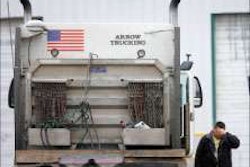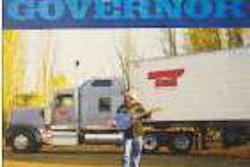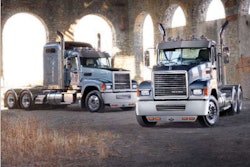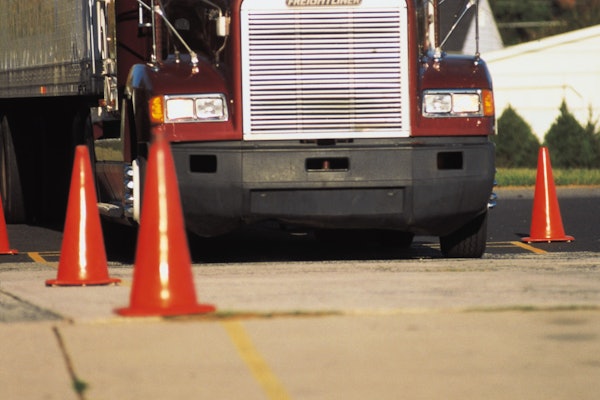Emotional control
 Avoid road rage chaos by distancing yourself from the traffic tussle
Avoid road rage chaos by distancing yourself from the traffic tussle
As traffic has grown and economic and social problems have increased, “road rage” is on the rise. More and more drivers are behaving in over-aggressive and erratic manners, such as frequently changing lanes or tailgating. On occasion, the traffic temper can boil over into dangerous or violent acts.
In April 2009 police arrested an Endicott, N.Y., tractor-trailer driver for an incident on Interstate 83 near Harrisburg, Pa. The truck driver allegedly bumped the back of a car with his rig three times during evening rush hour.
A trucker was shot by a motorist in an incident last June near Louisville, Ky. The attack took place after the drivers pulled to the road shoulder and began arguing, according to local police.
Last August near Syracuse, N.Y., a man driving a semi rammed a car that wasn’t going fast enough and wouldn’t move out of his way, according to New York state troopers. Police said the trucker later choked and beat the auto driver.
Last November, Maryland state police arrested a tractor-trailer operator for pointing a fake gun at a dump truck driver on the Baltimore Beltway, according to an Associated Press story.

What makes you boil behind the wheel? Unless you’re a saint, you’ve been guilty of getting steamed when driving. Most of you have probably observed another driver’s anger and reckless behavior, such as the preceding examples of over-the-top trucker behavior.
Over-the-road truckers witness all sorts of driving antics, from purely inattentive or selfish ones to things that could cause injuries and accidents. “I see cars itching to get around me, then get in front of me and then brake to get off at the next exit,” says Harold McBride, an owner-operator from Port St. Lucie, Fla. “I wonder why couldn’t you stay behind me and get off one second later.”
Truckers say the best way to deal with aggressive or angry drivers is to back off and stay away from them. “Nothing you can do about it,” says Tommy Gentry, a company driver for Troy Sims Trucking, Russellville, Ark. “We have to leave extra room for the cars. They normally take advantage of the situation because we’re bigger and slower. If it’s real bad and dangerous, all you can do is call 911.”
Gentry says he’s witnessed highway situations severe enough to call 911. “I think two times I’ve seen things that I thought would eventually hurt somebody, and I’ve called 911 with the tag number, the highway and what mile marker we’re at,” he says.
Doug Krach, an owner-operator from Salem, N.Y., leased to Daily Express, says truckers often can avoid confrontations with angry drivers by anticipating traffic ahead. “A lot of it is anticipation,” he says. “That’s what we do. [The problem is] the four-wheelers’ lack of anticipation of what a trucker wants to do. One in a thousand four-wheelers will anticipate what others are doing.”
McBride says he scans the traffic ahead looking for potential problems. “If I see something dangerous ahead, I always slow down to maintain that barrier between me and the vehicles ahead of me.”
Gentry says he can tell which drivers are aggressive and potentially dangerous by watching vehicle movement. Frequent lane changes, honking and hand gestures are a sure tipoff that someone’s driving with a short fuse.
Drivers also need to watch out for potential scams on the road, such as intentional “accidents.” “It’s gotten to the point nowadays there are people who slow down purposely so we’ll hit them,” Gentry says. “They can cash out if they get hit by a truck, and they know that. That causes you to get aggravated a bit.”
Patience is a virtue for Krach. He typically drives 60-62 mph and slows down if he confronts road rage or other aggressive driving. “If I get mad and make a mistake out there, somebody’s life is in danger,” he says. “If somebody cuts in front of me because I’m going too slow, I don’t worry about it.”
That wasn’t always the case. When Krach first started driving nine years ago, he would react to other drivers’ actions. “I would say things. Of course, they couldn’t hear me,” he says. “What good does it do? When you’re driving and have that attitude, you can take a life away, and I never want to do that.”
 Harold McBride eases his stress level by getting adequate sleep and choosing loads that aren’t under a severe deadline.
Harold McBride eases his stress level by getting adequate sleep and choosing loads that aren’t under a severe deadline.
In the early days of his career, more than 20 years ago, McBride says he was aggressive. “I’d get on their bumper, [figuratively] pushing them down the road,” he recalls. “I was always passing people because I couldn’t get to where I was going quick enough. But I was never late, and I never had any accidents. I used to eat a bottle of Rolaids a week.”
McBride says he changed his ways about 15 years ago when he found religion. “I got saved,” he says. “Now I pray all the way. I slowed down. I got my own truck and trailer. I find my own freight, so I don’t have to worry about high-pressure dispatch. Nobody’s life is worth a piece of freight.”
 Doug Krach says most road-rage problems can be averted by watching out for traffic ahead and anticipating driver maneuvers.
Doug Krach says most road-rage problems can be averted by watching out for traffic ahead and anticipating driver maneuvers.
McBride says he sees young truck drivers do the same things he did when he was a younger. “I’ll get on the CB and ask, ‘What if that was your mother in that car?’”
His prescription for dealing with inconsiderate drivers is to drive under the speed limit. “I don’t take any loads that have a long ways to go and a short time to get there,” he says. “I get plenty of sleep.”
While accounts of truckers exhibiting road rage crop up in truckstop conversations and on Internet blogs, Gentry says he’s never witnessed truckers getting carried away like four-wheel drivers do. “I’ve heard of truckers getting mad at each other, not at cars,” he says. “We expect each other to have common courtesy. I’ve never seen a truck purposely do something that aggressive. If they did, there’s a lot of us out here [to report them]. Most trucks have 800 numbers on them to call in. Most truck drivers have a lot more at risk than the average driver.”
While road rage is a concern, what really irritates Krach is motorists texting on a cell phone when driving. “I’ve seen guys driving with their knees and texting,” he says.
Aggressive Driving or Road Rage?
According to Arizona Department of Public Safety Sgt. Robert L. Hohn, there is a difference between aggressive driving and road rage. Aggressive driving is a traffic offense or combination of offenses such as following too closely, speeding, unsafe lane changes and other forms of negligent or inconsiderate driving. An aggressive driver is usually set off by traffic congestion along with a time pinch. In trying to make up time, the driver generally commits multiple violations. These sometimes lead to an accident.
Road rage, however, is a criminal offense, according to Hohn. For example, a traffic incident escalates into a far more serious situation. A person may get angry over an aggressive driving incident and overreact and retaliate with violence. These violent acts may range from a physical confrontation to assault with a motor vehicle or a weapon.
Best and Worst Places for Road Rage
Most Road Rage
1. New York City
2. Dallas/Ft. Worth
3. Detroit
4. Atlanta
5. Minneapolis/St. Paul
6. Phoenix
7. Miami
8. Houston
9. Cincinnati
10. San Diego
Least Road Rage
1. Portland, Ore.
2. Cleveland
3. Baltimore
4. Sacramento, Calif.
5. Pittsburgh
6. Washington, D.C.
7. Philadelphia
8. St. Louis
9. Boston
10. Seattle
Source: AutoVantage
 How to Avoid Road Rage
How to Avoid Road Rage
• Don’t retaliate. Don’t take the other driver’s actions personally.
• Don’t make eye contact with an angry driver. That person is looking to engage you.
• Control your emotions. Roll up your window and yell to yourself or sing to relieve agitation. Take a deep breath, release it slowly and repeat.
• Remain polite and courteous. Respect other drivers.
• Slow down safely and let the aggressive driver pass or move into your lane.
• Anticipate potential problems by watching traffic ahead.
• If an aggressive driver’s actions appear dangerous call 911 with location and vehicle description.
• Reduce your driving stress by scheduling enough time to get to your destination.
• Control your actions and remain calm.











